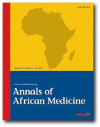
|
Annals of African Medicine
Annals of African Medicine Society
ISSN: 1596-3519
Vol. 3, No. 1, 2004, pp. 17-21
|
 Bioline Code: am04006
Bioline Code: am04006
Full paper language: English
Document type: Research Article
Document available free of charge
|
|
|
Annals of African Medicine, Vol. 3, No. 1, 2004, pp. 17-21
| en |
Spectrum of Rheumatic Heart Disease in Zaria, Northern Nigeria
Danbauchi, S. S.; Alhassan, M. A.; David, S. O.; Wammanda, R. & Oyati, I. A.
Abstract
Background:
Rheumatic heart disease (RHD) is a disease that is still prevalent in the developing countries and still poses a major medical and cardio-thoracic surgery challenge in Nigeria.
Method:
A study of data from echocardiography laboratory from October 1999 - September 2002.
Results:
Forty-seven (47) out of 600 echocardiography scans had a diagnosis of rheumatic heart disease from October 1999 to September 2002. They were made up of 32 females and 16 males (female/male ratio of 2:1). The ages of the patients ranged from 5 to 52 years with a mean of 19.51 +/- 1.4. There was no statistically significant difference in the mean age of female and male patients. Nearly 90 % of the referring Physician made the correct diagnosis of rheumatic heart disease. Forty eight percent of the patients had depressed left ventricular function (EF < 50%). The mitral followed by the aortic valves were the most commonly affected. Sixteen percent of the patients had severe mitral stenosis. Mitral valve disease whether pure regurgitation, stenosis or combined disease was more common in patients below the age of 25 years. The mean Wilkins score of patients with severe mitral stenosis was 6.8 +/- 1.2. Two patients had aortic valve disease and were above the age of 25 years. The complications included mitral valve prolapse in 19.6%, atrial fibrillation, endocarditis, pericardial effusion and rupture of chordae tendinae. Only 0.7% had surgical intervention but the rest were managed medically. Percutaneous transluminal balloon mitral commissurotomy is not part of management armamentarium.
Conclusion:
The mitral and the aortic valves are most commonly affected valves. Patients with critical mitral stenosis have a favourable anatomy for PTMC but it is not available, and a negligible number have the opportunity to have surgical intervention. The need to develop some cardio-thoracic centres as matter of urgency is recommended so as to alleviate the patients' suffering.
Keywords
Rheumatic, heart, disease, spectrum
|
| |
© Copyright 2004 - Annals of African Medicine.
Alternative site location: http://www.annalsafrmed.org
|
|
